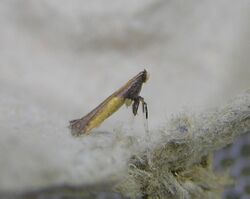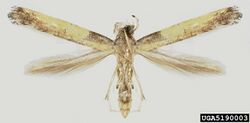Biology:Caloptilia azaleella
| Azalea leaf miner | |
|---|---|

| |

| |
| Scientific classification | |
| Domain: | Eukaryota |
| Kingdom: | Animalia |
| Phylum: | Arthropoda |
| Class: | Insecta |
| Order: | Lepidoptera |
| Family: | Gracillariidae |
| Genus: | Caloptilia |
| Species: | C. azaleella
|
| Binomial name | |
| Caloptilia azaleella (Brants, 1913)[1]
| |
| Synonyms | |
| |
Caloptilia azaleella (azalea leaf miner) is a moth of the family Gracillariidae. It is endemic to Japan , but has been introduced worldwide, wherever there are Azaleas.[2]
Distribution
Initially described in the Netherlands from plants imported from Japan, it is found throughout Europe and has also been introduced to New Zealand and eastern Australia.[3] In the southern part of Britain it occurs in sheltered gardens including Buckingham Palace, the Royal Botanic Gardens, Kew and the Royal Horticultural Society Gardens, Wisley.[4] It has been widely reported in greenhouses. In the United States the species can be found from Florida to Texas , and as far north as Long Island, West Virginia, and the Ohio Valley.[2] On the west coast it is found in California, Washington and British Columbia, Canada.[5]
Description
The type locality is from Boskoop, Netherlands, and was described in 1913, from moths reared on Azalea indica, a cultivar of Rhododendron indicum, which was imported from Japan.[4] The moths forewings are mainly dark-brown with a yellow band along the costal margin. The wingspan is 10–11 millimetres (0.39–0.43 in) and it flies from May to October depending on location and in Britain is double-brooded and sometimes there is a partial third brood.[6]
Ecology
Caloptilia azaleella deposits its eggs on azalea (Rhododendron spp) plants, under leaves near the midrib. Thiese are the only hosts so far recorded.[2] The larva initially forms a mine and later rolls the leaf downwards from the tip, forming a cone.[6] When mature a pale-brown pupa is formed in a white, membranous silken cocoon spun beneath a leaf and the moths can mate a week later.[2][4]
References
- ↑ "Caloptilia azaleella (Brants, 1913)". Fauna Europaea. 23 July 2012. http://www.faunaeur.org/full_results.php?id=433830. Retrieved 27 January 2017.
- ↑ 2.0 2.1 2.2 2.3 "Azalea leaf miner". University of Florida. http://entnemdept.ufl.edu/creatures/orn/shrubs/azalea_leafminer.htm. Retrieved 27 January 2017.
- ↑ "Caloptilia azaleella (Azalea leafminer moth)". http://www.terrain.net.nz/friends-of-te-henui-group/moths/caloptilia-azaleella-moth-azalea-leafminer-caloptilia-azaleella.html. Retrieved 27 January 2017.
- ↑ 4.0 4.1 4.2 Emmet, A M; Watkinson, I A; Wilson, M R (1985). Emmet, A Maitland. ed. The Moths and Butterflies of Great Britain and Ireland. Volume 2. Colchester: Harley Books. p. 262. ISBN 0-946589-19-4.
- ↑ "017250 – 0592 – Caloptilia azaleella – Azalea Leafminer Moth – (Brants, 1913)". http://mothphotographersgroup.msstate.edu/species.php?hodges=592. Retrieved 27 January 2017.
- ↑ 6.0 6.1 "Azalea Leaf Miner Caloptilia azaleella". http://www.ukmoths.org.uk/species/caloptilia-azaleella/distribution-map. Retrieved 27 January 2017.
External links
Wikidata ☰ Q793503 entry
 |

